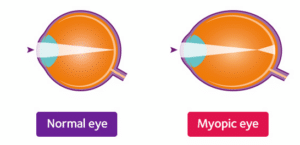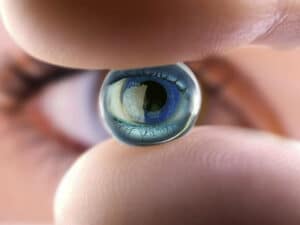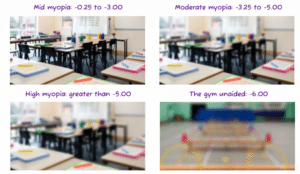What is short sightedness?
Myopia, also known as short sightedness, is a common eye condition that causes blurry vision when looking at distant objects, while allowing for clear vision of close-range items. This occurs because the eyes become elongated beyond the average length required for normal long-distance vision.
In the United Kingdom, approximately 17.8% of the population, or roughly one in every six adults, experiences myopia. It typically develops during the school years, typically between the ages of 6 and 14.
During the teenage phase, as the body undergoes rapid growth and the eyes are subjected to prolonged periods of near work, myopia tends to progress gradually. However, it often stabilises in early adulthood. The severity and impact of myopia can vary greatly among individuals, ranging from mild cases to more severe forms that significantly impair visual acuity.
Causes of Short Sightedness
The exact factors that contribute to the development of short sightedness remain a mystery, although our understanding of myopia has advanced significantly through extensive scientific research in recent years. There is a growing consensus among experts that both genetic and environmental factors are involved in the emergence of myopia.
Interestingly, the prevalence of myopia varies among different ethnic and geographic populations, with East Asian communities having the highest rates. Furthermore, several studies have shown a correlation between parental myopia and an increased likelihood of their children developing the condition.
In fact, children with one short sighted parent are twice as likely to be short sighted compared to those whose parents have no history of the condition. This risk increases significantly to almost eight times when both parents are short sighted.
Although genetic factors undoubtedly contribute to myopia, the increasing prevalence of this condition over time suggests that environmental factors, such as near work and outdoor activities, also play a significant role.
Signs you or your child may be short sighted include:
- difficulty reading words from a distance, such as reading the whiteboard at school
- sitting close to the TV or computer, or holding a mobile phone or tablet close to the face
- getting headaches
- rubbing the eyes a lot
Short sightedness often runs in families, so you may have relatives who are also short sighted.
It can get worse until the eye has stopped growing, at around 20 years of age.
How our eyes react
When we closely examine objects, our eyes need to adjust and focus on the nearby object, creating its image on the retina located at the back of the eye. This is crucial for clear vision. However, there are instances when our eyes struggle to meet the required focus demand, resulting in a blurry image formed behind the retina.
To address this issue, our bodies instinctively try to rectify the situation by elongating the eye in an effort to bring the image into focus and eliminate blurriness. Paradoxically, this solution proves to be counterproductive as it actually contributes to the progression of short sightedness.
Activities such as reading at a short distance, engaging in near work, or prolonged reading are closely associated with the development of myopia. As a result, studies have indicated that individuals who have received 10 or more years of education may experience an increase of approximately 0.60 mm in the length of their eyes.
Ever Wondered What it is Like to be short sighted?
For individuals who have not personally encountered short sightedness, comprehending the true magnitude of its incapacitating consequences and how it affects your child’s everyday existence can prove to be a formidable task.
The subsequent depictions and simulated visuals have been created with the sole purpose of enabling you to genuinely comprehend the situations your myopic child confronts, thereby granting you an immersive experience from their unique perspective.
The importance of time outdoors
Participating in outdoor pursuits has been associated with a decrease in the progression of myopia. Research indicates that allocating 2 to 3 hours towards concentrating on faraway objects can counterbalance the effects of prolonged engagement in near tasks spanning 9 to 12 hours.
Moreover, scientific studies have demonstrated that exposure to natural sunlight stimulates the retina to release dopamine. This release of dopamine aids in hindering the enlargement of the eyes, thus effectively decelerating the advancement of myopia.
How many people are short sighted?
A recent study conducted in the United Kingdom brings attention to the concerning prevalence of myopia among children. Shockingly, it was found that 2% of children aged 6-7 years old were impacted by this visual impairment, while an alarming 15% of 12–13-year-olds were affected.
What makes this revelation even more intriguing is the emerging pattern observed by researchers. They have noticed a strong correlation between the increasing prevalence of myopia and its onset at progressively younger ages. This phenomenon means that individuals now have a longer period for the progression of myopia, potentially leading to a more severe condition known as high myopia.
Can we avoid short sightedness?
There have been considerable efforts made to address the progression of myopia, and fortunately, some have yielded positive results. If you are interested in delving deeper into this topic, I suggest seeking guidance from a professional eye care specialist. To prevent the advancement of myopia, it is wise to incorporate a few simple practices into your daily routine.
Remember to take regular breaks during activities that require close-up focus and shift your gaze towards objects in the distance. Furthermore, spending time outdoors has proven to be beneficial in this regard. If you happen to be short sighted, it is vital to undergo regular eye examinations, ideally every two years.
Nevertheless, if you have any concerns regarding your vision, it is wise to schedule an appointment at your convenience. If you have any further inquiries about eyesight or myopia, please feel free to reach out to us without hesitation.
Book regular eye exams.
As you journey through the stages of life, your eyes embark on a continuous journey of transformation, much like the ever-changing landscape of time. It is of utmost importance to prioritise regular eye examinations to detect any potential deviations that may impede your vision and safeguard the long-term wellness of your eyes.
If you happen to notice any alterations in your visual perception as you navigate through life’s tapestry, it is crucial to confide in a responsible adult about these changes. By promptly sharing your observations of shifting eyesight, you grant your trusted optometrist the invaluable opportunity to offer timely interventions and effective strategies for managing these transformations.
Book an eye exam with us today!
Options for your child
If your child has been diagnosed with myopia, there are some clinically effective options that can slow the worsening of myopia. Discuss the best option for your child with your eye care professional.
DUAL-FOCUS MYOPIA MANAGEMENT: MISIGHT® 1-DAY CONTACT LENSES
- One-day soft contact lenses, which are worn during the day
- Ideal for active children
- Clinically proven for children aged 8+
- Feel more competent when taking part in sports and other physical activities.
MYOPIA MANAGEMENT GLASSES AND LENSES
- Worn during the day
- A good choice if your child diligently wears their glasses
- Ideal for younger children
ORTHOKERATOLOGY CONTACT LENSES
- Hard contact lenses worn overnight
- Lens-free during the day
- Ideal for children who frequently enjoy swimming and water sports where glasses and soft contact lenses may not be suitable.
Manage Myopia in Children
In conclusion, as we continue to see a rise in myopia among children, it is crucial to take proactive steps towards managing and treating this condition. With the introduction of innovative solutions like MiSight® 1-day contact lenses, we now have a tool to not only correct vision impairments but also slow down the progression of myopia.
It is important to stay informed and take the necessary measures to ensure a better future for our children’s eye health.
Let us work towards reducing the prevalence of myopia and creating a brighter tomorrow for our younger generations.




